6 Elements of Thriving Learners
Key Points
-
Schools aren’t to blame for last year’s Insurrection, but they can be part of the long-term solution.
-
After nearly two decades of designing creative schools around the world, Fielding International has defined six elements for thriving learners.
-
Each thriving element is mapped to a series of design patterns at SchoolPatterns.com to help schools shape environments where learners thrive.
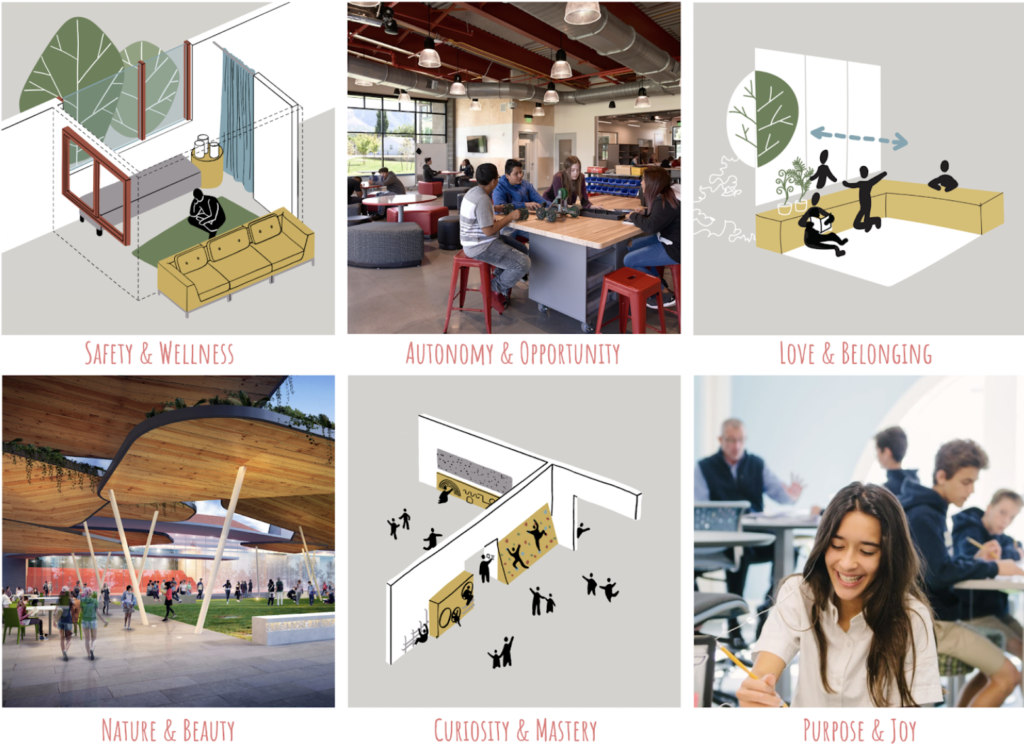
By: Randy Fielding and Nathan Strenge
One year ago from this publication, on January 6, 2021, people from around the world witnessed an American Insurrection. A confluence of factors led to this event, and it’s not the goal of this article to diagnose them. What is worthy of investigation is thinking about the role education can play to create conditions that counteract the forces that led to the Insurrection.
At Fielding International, we are known for designing schools that foster authentic collaboration, creativity, wellness, and learner agency through the built environment. We do this using a holistic design approach that aims to align a school’s vision, educational program, and physical environment. We have seen what happens when schools do what Todd Rose describes in The End of Average, which is to stop designing for some false middle, and rather design to reach the edges of the population. Any school community can do this, but it takes a fundamental rethinking of priorities. It starts by asking three essential questions:
- What makes learners thrive?
- What are the environmental characteristics that support thriving?
- What are the barriers to thriving?
After two decades of designing reimagined schools in over 50 countries, we’ve put our own spin on question #1: what makes learners thrive. We are embedding these into the creation of a free open-source library of design patterns for thriving learners at SchoolPatterns.com. As you read, we encourage you to think about the future impact if more of our young people were to learn in environments that adapt to each person’s unique set of needs, gifts, and life experiences through these six elements.
Safety & Wellness
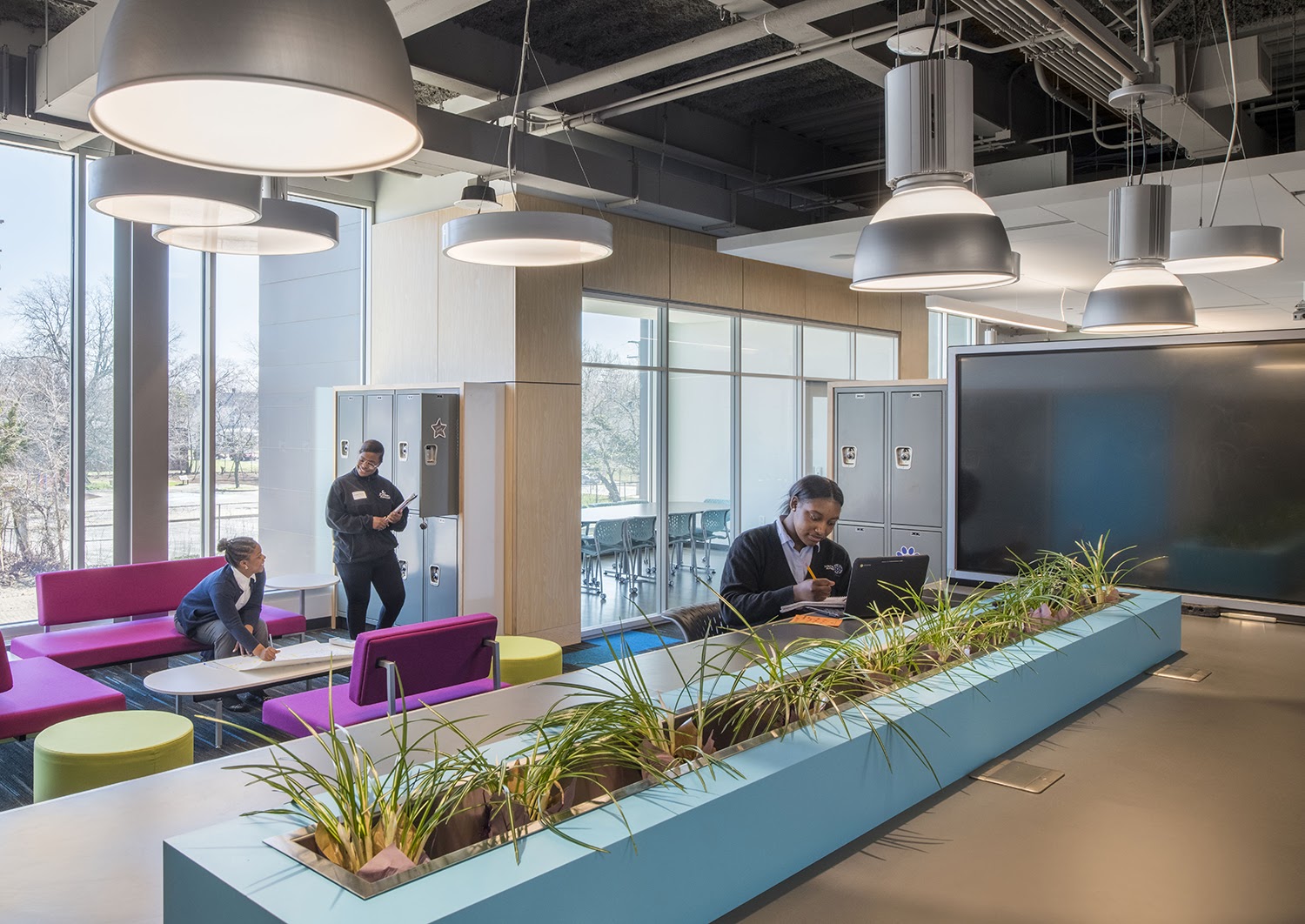
We can see several characteristics that nurture a feeling of safety and wellness in the image of St. Martin de Porres High School above. The soft seating and small clusters of lockers are designed for comfort and can equally serve both individuals and family-size groups. In contrast, large banks of lockers lining a corridor require each individual to turn their back to a large, noisy group of peers, making it difficult for meaningful interactions and a barrier to a sense of safety and wellness.
The wood-paneled partial wall at the center provides a solid, comforting edge to the soft-seating area. The view outside to trees and the city offers students a sense of connection to something larger than themselves, as well as a long vista that allows them to change their eye’s focal length–essential to eye health. The generous work surface in the foreground invites students to carve out their own space and spread out their work, while the green planter in the foreground provides a soft and oxygen-enhancing edge to the work counter.
Many of the physical security measures go unnoticed by the untrained eye, including mechanisms to layer access inside and outside the building. This is international – good design in this domain creates spaces that foster movement, well-being, and social connections without sacrificing physical safety.
| Impact: When healthy people feel a sense of safety, both internally and externally, a key aspect of their foundational needs is met. They are in a mental and physical state that prepares them for deeper learning, critical thinking, and enriching relationships. |
Purpose & Joy
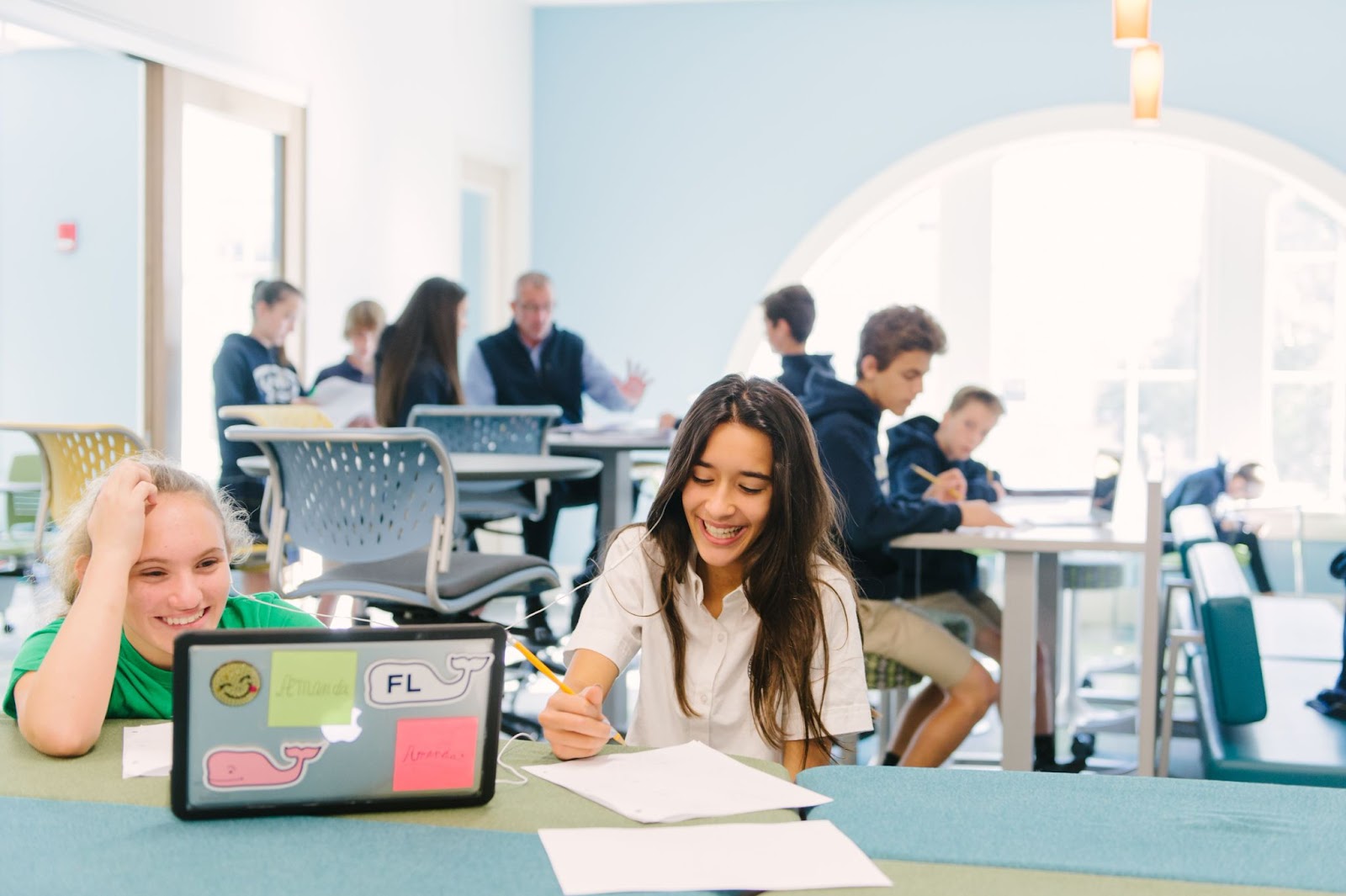
We can see several characteristics that nurture a feeling of purpose and joy in the image of the Academy of the Holy Names Middle School above. The varied seating and desk styles and arrangements invite students to be intentional about their purpose–to work independently, to collaborate actively, or read quietly.
Abundant natural light in conjunction with low-glare general lighting, complimentary wall surface colors, and sparks of colorful accent lighting contribute to an atmosphere of joyful, human-centered beauty rather than institutional sameness.
The generous arched window offers a dramatic visual connection to the world outside. Multiple doorways to the left offer fluid connections to adjacent spaces and learners. Together with a light-filled room, learners feel a sense of safe enclosure and stimulating and uplifting connections–key building blocks of purpose and joy.
| Impact: Experiencing environments that bring joy and catalyze purpose-driven learning unleashes human potential. When authenticity and relevancy become the drivers of curriculum and pedagogy, community difference-making becomes a north star. |
Curiosity & Mastery
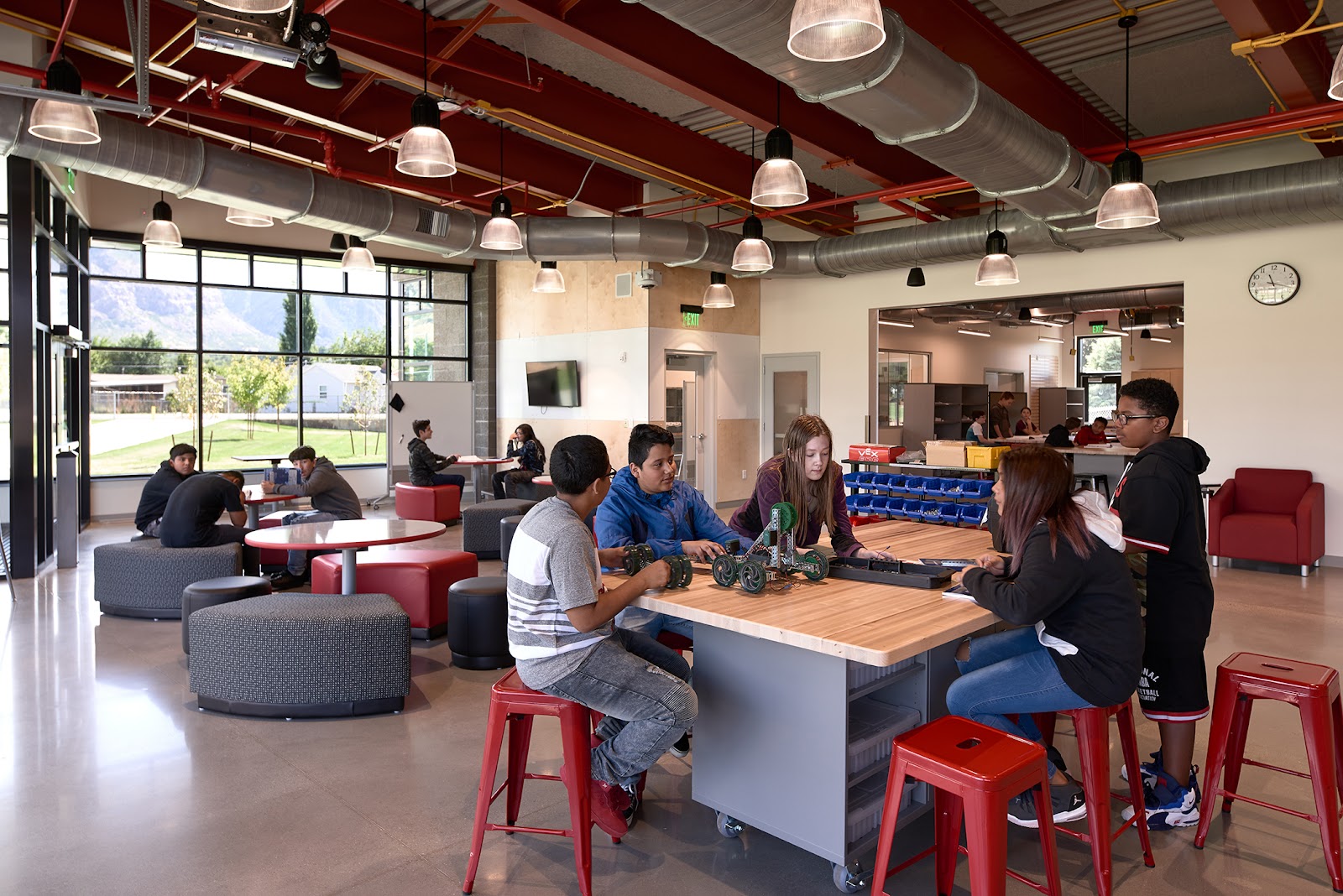
We can see several characteristics that nurture a feeling of curiosity and mastery in the image of Mound Fort Innovation Center above. Round tables near large windows invite learners to engage each other in conversations about their own questions, aspirations, and the needs of the world around them. Standing height workbenches with space on all four sides allow learners to gather, define problems, brainstorm solutions, and create prototypes.
Wide openings between spaces with overhead glass doors welcome learners to explore the work of multiple groups while providing the flexibility to focus, with the doors down, or engage adjacent groups with the doors open. A high, open ceiling provides a sense of space and freedom to explore problems, a diversity of solutions, and to see the big picture with an open mind. Mobile tool carts, restocked to support the needs of changing, interdisciplinary projects, arm students to gain mastery in their chosen challenges.
| Impact: Curiosity is the desire to learn. When humans desire to learn something, they pursue it with vigor until they have a deep understanding and mastery of it. When environments support interdisciplinary learning that addresses real community problems, civic engagement is a natural outcome. |
Love & Belonging
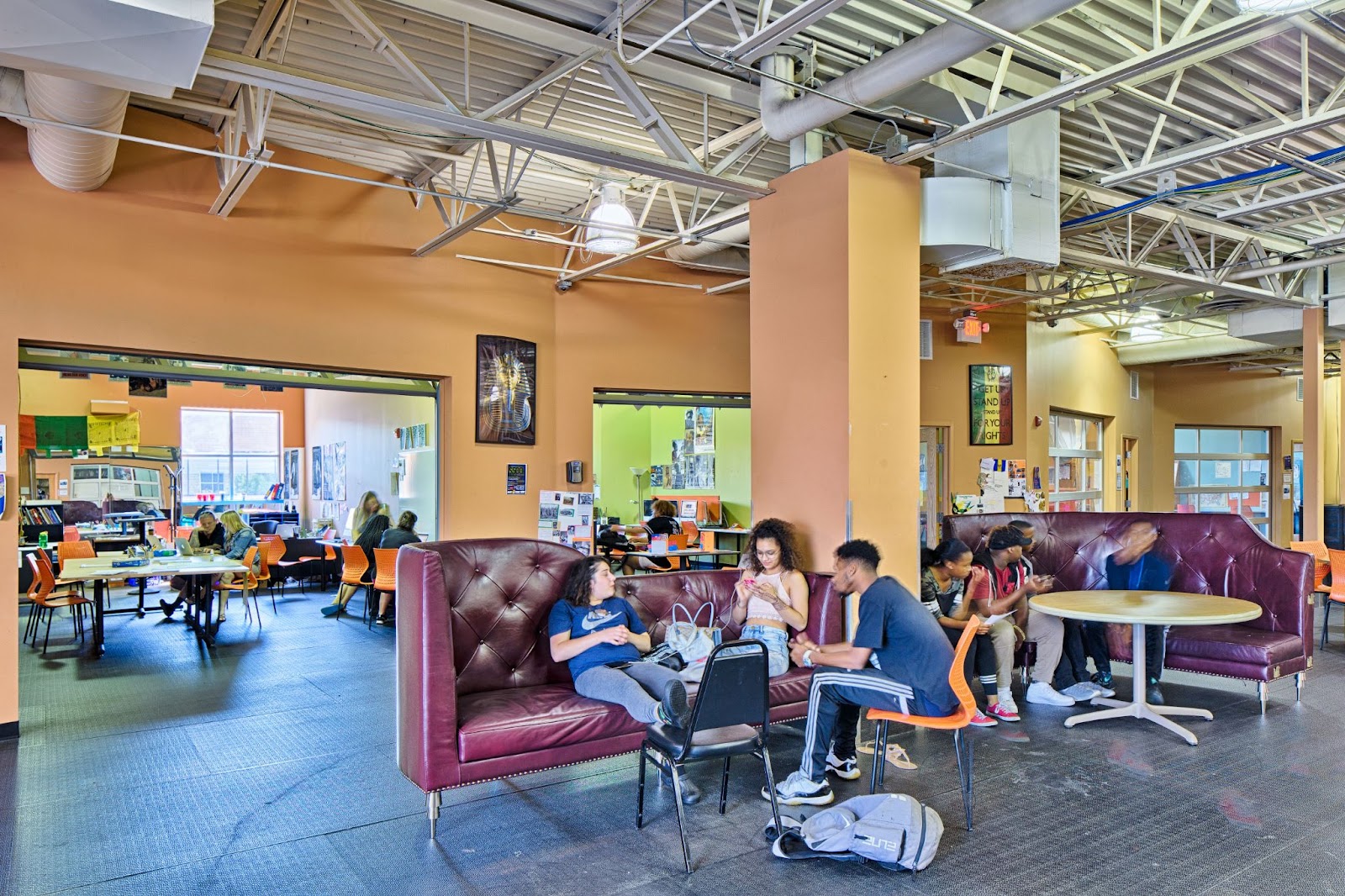
A variety of spatial elements foster a feeling of love & belonging in the image of High School for Recording Arts above. At the center, the Learning Commons serves as the beating heart of the Learning Community, with soft seats, gathering and performance areas, abundant natural light, and views to the city. The variety of adjacent activity zones and diversity of views provide a sense of belonging and connectedness.
The Learning Commons is surrounded by Learning Studios where each student belongs to an advisory group of 12-18. The advisory groups are small enough to allow each student to develop strong relationships with each other and an adult advisor. High-back couches in the heart provide a sense of enclosure and individual space, tempering the potential for over-stimulation by the variety of activity zones and visual connections.
Glass overhead doors connecting Learning Studios to the central Learning Commons allow advisory groups to operate in a quieter, cozier mode or to connect to the larger community. Even with the doors closed, the visual connection provides a sense of belonging to a larger group. (This is in contrast to the “cells and bells” classroom and corridor model, where classrooms are siloed).
As one of our oldest clients and co-located in the Twin Cities, we’ve had the opportunity to connect with many HSRA students and alumni. It’s been incredible how many times over the years we’ve heard some version of, “that school saved my life.” When we dig into what was so valuable about the experience, it almost always comes down to a feeling of love & belonging through authentic relationships with teachers and peers.
| Impact: Elie Wiesel wrote, “The opposite of love is not hate, it’s indifference.” When our kids grow up in communities that center on deep and trusting relationships, they cultivate love & belonging. Through diverse interactions with growing social circles, kids actively learn to care about the world and the people who inhabit it; they learn to love themselves for the uniquely incredible individual they are, and they seek to spread that love to others. |
Autonomy & Opportunity
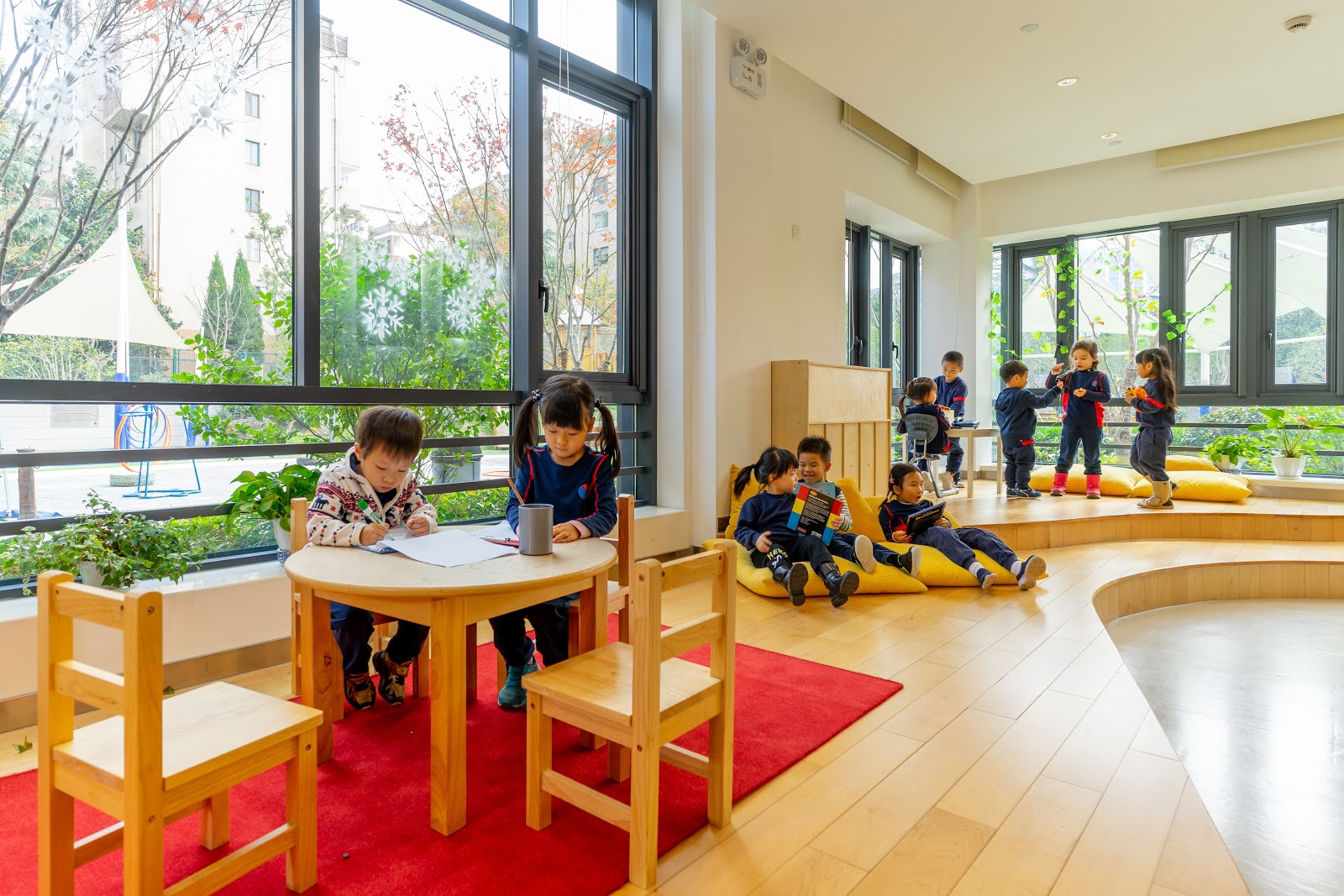
A variety of sensory-rich activity zones inside, and direct access to equally engaging outdoor learning spaces outside, provide choice and opportunities for young learners at the YCIS Early Learning Center in Shanghai.
Curved wooden platforms at various heights evoke the varied topography found in nature. Students choose paths and spaces with autonomy rather than satisfying requirements for “seat time.” Platform edges and soft floor cushions serve as additional seats–learners have the opportunity to choose the type and location where they sit and how they engage their work and each other.
Large windows connect students visually to outdoor water play, topographically varied outdoor learning spaces, and a musical discovery structure; all engaging children’s sense of adventure, opportunity, and autonomy.
| Impact: Giving young people opportunities to learn independently and to seek out meaningful experiences gives rise to self-efficacy. Young people who believe in themselves and are in supportive environments seek out new opportunities, new challenges, new connections, and new ways of contributing to the world around them. |
Nature & Beauty
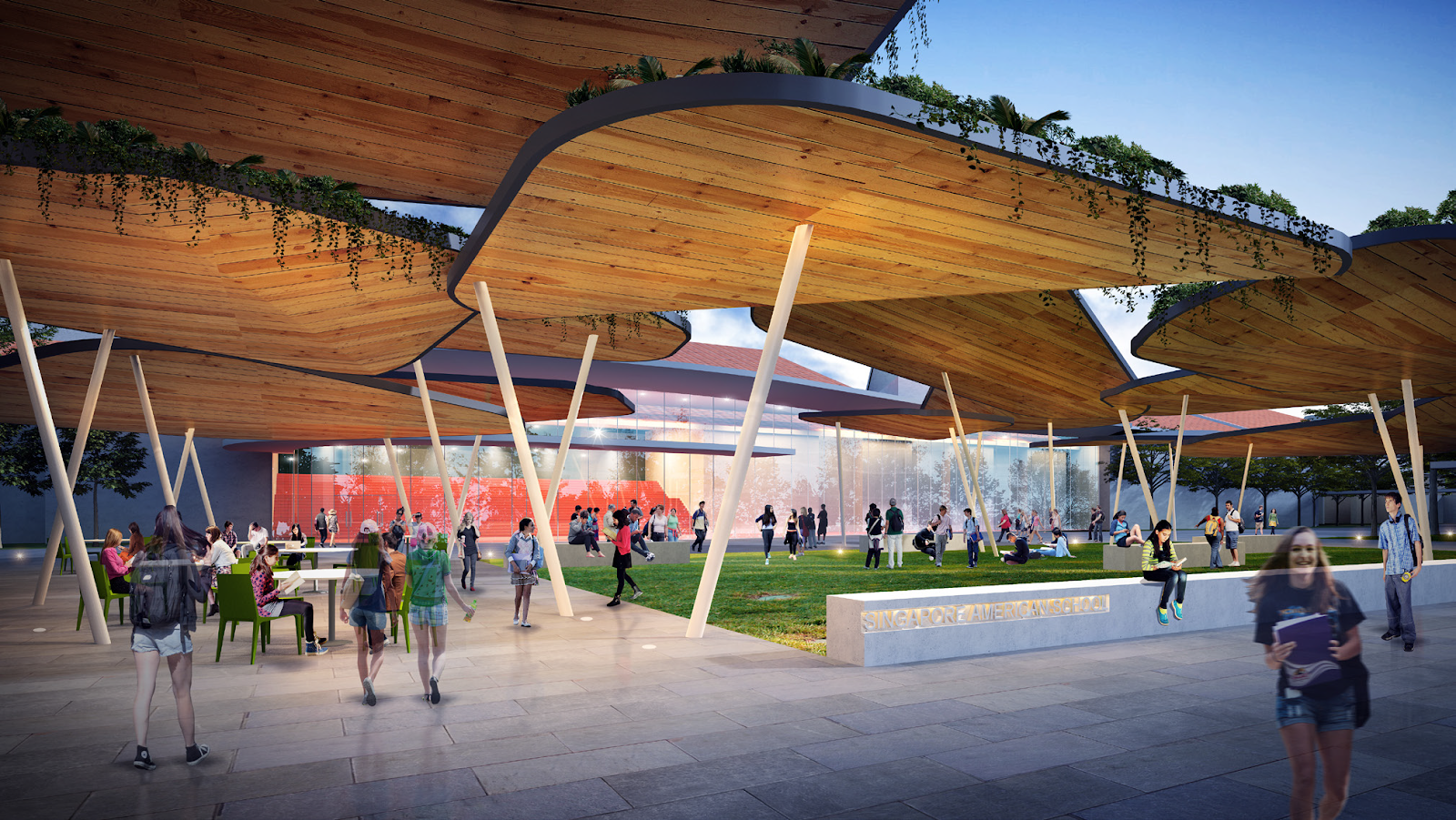
A universal yearning and priority that we hear in experiences with learners around the world is the desire for more connections to nature. As we engage in deeper discussions across cultures, we also hear that the surprising, ever-changing patterns in nature represent the essence of beauty, spirituality and connectedness.
The new entry at Singapore American School, pictured above, evokes nature through the organically shaped petal forms, the natural wood cladding, the randomly angled column forms, and the green vines above. Nature, beauty and a place to gather and connect grounds us in the beauty of common values and who we are as human beings.
| Impact: There can be beauty in the built environment and in the natural environment. When young people grow up connected to nature and in beautiful spaces, they come to care for both. This burgeoning sense of responsibility comes with greater wellness and appreciation for the arts, for the Earth, and for life itself. |
Conclusion
What do spatial design patterns have to do with the events in the US Capitol on January 6, 2021? What role can education play to create conditions that counteract the forces that led to the Insurrection? How are we going to cultivate a generation of civically-minded problem solvers who are ready to take on the challenges facing humanity throughout the 21st-century and beyond? These questions boil down to what we most desire out of our schools. If we desire the six elements for thriving learners, we have to actively design for them. This can be done, but isn’t going to depend on individual heroes or a new policy mandate. It’s going to be done locally, with groups of young people, educators, parents, and community members coming together, discussing, and taking action on the three essential questions:
- What makes learners thrive?
- What are the environmental characteristics that support thriving?
- What are the barriers to thriving?
We at Fielding International have seen the real-time effects of thriving learners. Kids and teachers have stronger relationships; they feel safe and loved; they pursue learning opportunities of relevance and meaning; they are healthy in mind, body, and spirit. These schools are cultivating a holistic ecosystem that gives kids opportunities to contribute to a thriving pluralistic society and healthy planet.
And a natural byproduct of this: kids who learn in these environments are primed to squash hatred, misinformation, ungrounded conspiracies, and extreme tribalism. We believe the long-term effects of this are existential and beyond measure. That’s why we are making our Design Patterns for thriving learners freely accessible to anyone, anywhere at SchoolPatterns.com.
If we can be helpful in your pursuit of environments where learners thrive, please reach out to us.
Nathan Strenge is a Senior Learning Designer at Fielding International, USA Country Lead at HundrED, and Founding Board Chair of Exploration High School. He can be reached at [email protected] or found on LinkedIn.





0 Comments
Leave a Comment
Your email address will not be published. All fields are required.